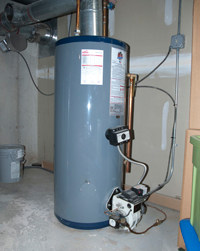How to Properly Maintain Your Home's Hot Water System
How to Properly Maintain Your Home's Hot Water System
Blog Article
What're your opinions concerning What Kind of Maintenance Do Water Heaters Need??

Warm water is necessary for everyday comfort, whether it's for a revitalizing shower or cleaning dishes. To guarantee your warm water system runs effectively and lasts longer, normal maintenance is key. This write-up supplies functional suggestions and understandings on exactly how to maintain your home's warm water system to avoid disturbances and expensive repair services.
Introduction
Keeping your home's hot water system could seem daunting, however with a couple of easy actions, you can ensure it runs smoothly for many years ahead. This guide covers everything from recognizing your warm water system to DIY upkeep suggestions and recognizing when to contact expert aid.
Significance of Keeping Your Warm Water System
Routine upkeep not just extends the lifespan of your hot water system yet also ensures it operates successfully. Disregarding upkeep can lead to reduced performance, higher energy expenses, and also premature failure of the system.
Indicators Your Hot Water System Requirements Upkeep
Knowing when your warm water system requires attention can avoid significant concerns. Look out for indications such as inconsistent water temperature, odd sounds from the heater, or rustic water.
Recognizing Your Warm Water System
Before diving right into upkeep tasks, it's practical to recognize the basic components of your hot water system. Typically, this includes the water heater itself, pipes, anode rods, and temperature level controls.
Regular Monthly Upkeep Tasks
Normal regular monthly checks can assist capture small problems prior to they intensify.
Purging the Water Heater
Flushing your water heater eliminates sediment accumulation, enhancing effectiveness and extending its life.
Checking and Replacing Anode Rods
Anode rods prevent corrosion inside the tank. Inspecting and changing them when worn is essential.
Inspecting and Readjusting Temperature Setups
Readjusting the temperature level settings guarantees optimal performance and safety and security.
Do It Yourself Tips for Upkeep
You can do a number of upkeep jobs on your own to keep your hot water system in top problem.
Looking for Leakages
Regularly inspect pipelines and links for leaks, as these can lead to water damages and greater expenses.
Examining Stress Relief Valves
Evaluating the stress safety valve ensures it functions correctly and avoids excessive stress accumulation.
Protecting Pipes
Shielding hot water pipes decreases warm loss and can save energy.
When to Call a Specialist
While DIY maintenance is advantageous, some problems need professional expertise.
Facility Problems Requiring Specialist Aid
Instances include significant leaks, electrical troubles, or if your water heater is consistently underperforming.
Routine Specialist Maintenance Benefits
Specialist maintenance can consist of extensive evaluations, tune-ups, and guaranteeing conformity with security criteria.
Final thought
Regular upkeep of your home's hot water system is necessary for effectiveness, longevity, and expense savings. By adhering to these suggestions and recognizing when to seek specialist assistance, you can ensure a trustworthy supply of hot water without unforeseen disruptions.
How to Maintain an Instant Hot Water Heater
Before tinkering with your hot water heater, make sure that it’s not powered on. You also have to turn off the main circuit breaker and shut off the main gas line to prevent accidents. Also turn off the water valves connected to your unit to prevent water from flowing into and out of the appliance. 2. When you’re done, you have to detach the purge valves’ caps. These look like the letter “T†and are situated on either side of the water valves. Doing so will release any pressure that has accumulated inside the valves while at the same time avoid hot water from shooting out and burning your skin. 3. When the purge valves’ caps are removed, you have to connect your hosing lines to the valves. Your unit should have come with three hoses but if it didn’t, you can purchase these things from any hardware or home repair shops. You can also get them from retail stores that sell water heating systems. Read the user’s manual and follow it to complete this task properly. When the hosing lines are connected, open the purge port’s valves. 4. You should never use harsh chemical cleaners or solutions when cleaning your unit. Make use of white vinegar instead. It should be undiluted and you’ll probably use about 2 gallons. 5. Now flush your water heater. This task should probably take about 40 minutes. We can’t give you specific directions for this because the procedure is carried out depending on the type, model and brand of your heater. With that being said, refer to the user’s manual. 6. When you’re done draining the unit, you have to turn off the purge port valves again. Remove the hosing lines that you earlier installed on each of the water valves. Put the valve caps (purge port) back in their respective places and be very careful so as not to damage the rubber discs that are found inside these caps. 7. Now that everything’s back in place, check your user’s manual again to find out how to reactivate your water heating system. 8. Once it is working, turn one of your hot water faucets on just to let air pass through the heater’s water supply pipes. Leave the tap on until water flows smoothly out of it. https://www.orrplumbing.com/blog/2014/september/how-to-maintain-an-instant-hot-water-heater/

As an avid person who reads about How to Maintain Your Water Heater & Prolong its Life, I assumed sharing that short article was a good thing. Enjoyed reading our write-up? Please quickly share it. Help another person find it. Thanks a lot for your time. Come back soon.
Book Service Now Report this page